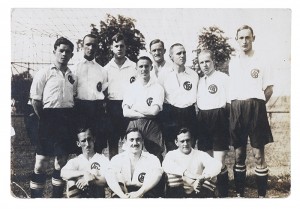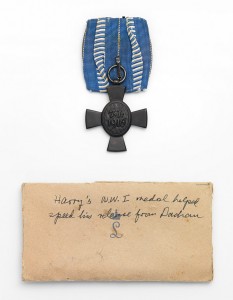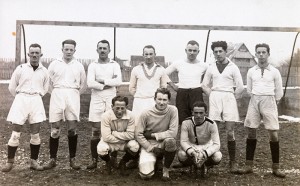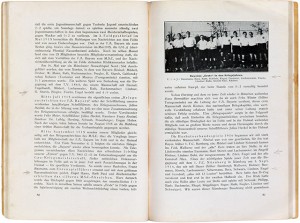Gems from our Collection

Harry Engel (1892-1950) with the FC Bayern Munich, Munich, September 1916
© Jewish Museum Berlin, donated by Alfred Engel, photo: Jens Ziehe
On 15 February 1940, after a four-year wait for an American visa then a successful escape from Nazi Germany, the Engel family, hitherto of Munich, reached the safe shores of Manhattan. In the family’s luggage was memorabilia that the then 13-year-old Alfred Engel was to donate to the Jewish Museum Berlin, decades later, from his father’s estate. It includes rare photographs from the 1910s, a time when Harry Engel (1892–1950) was an active soccer player at FC Bayern Munich.
It was a seemingly nondescript sheet of notepaper that drew my attention to the bundle of objects comprising Harry Engel’s legacy when I was reviewing the content of our archives in preparation for the forthcoming exhibition “The First World War in Jewish Memory.” The note, handwritten in English, stated that Harry had been imprisoned in the Dachau concentration camp but that his First World War medal had helped him secure an early release. The note was thus a personal comment on the King Ludwig Cross, a Bavarian Order of Merit awarded as a “token of commemoration and recognition of those who during this war have performed with particular merit for the army or for the general welfare of the homeland through official and voluntary activities” and that Harry Engel took with him into exile.

Harry Engel’s (1892-1950) “King Ludwig Cross,” a Bavarian Order of Merit, with the handwritten note, Bavaria, 1916-1918; note: second half 20th century
© Jewish Museum Berlin, donated by Alfred Engel, photo: Jens Ziehe
Of course, to what extent the Order actually did help Harry Engel secure an early release from the concentration camp to which he had been admitted on 10 November 1938 can no longer be verified. The brief note does attest, however, that this is the story the family members associate with the war medal. It is hence an extraordinary document and, from our present perspective, as important as the Order itself.
Like a magnifying glass, it brings sharply into focus those perceptions of the First World War handed down within German-Jewish families. Memories of that war are closely interwoven with what happened between 1933 and 1945: the families’ sense of being an integral part of German society and their subsequent exclusion from it are irrevocably linked. It is a godsend for us, the museum, to have found succinct yet irrefutable evidence of these conflicting associations in the form of a handwritten note, a tangible object apt for display. They are commonly reflected in the personal histories recounted by friends of the Jewish Museum and then documented of course, but visual evidence of them is a rarity. (Tim Grady, author of The German-Jewish Soldiers of the First World War in History and Memory, a book I can highly recommend, will present his research on 3 September 2014, here in the Museum.)

Harry Engel (1892-1950) with the FC Bayern Munich, Munich, ca. 1919
© Jewish Museum Berlin, donated by Alfred Engel, photo: Jens Ziehe
Moreover, not only the Order and the note, but also the football photos from the Engel collection are perfect gems. The FC Bayern Munich celebrates its centenary this year and its archive expressed great interest in the photos when I made enquiries there about Harry Engel. He is certainly no stranger to the archive but his fortunes later in life were largely unknown and—given that plans are afoot to document past players’ biographies—access to his material would be welcomed. According to player stats, Engel played in a total of 104 games in the years 1913–1919 and ranked permanently among the regular first team players from July 1915 onwards. Two of the photos in our collection can also be found in a commemorative brochure published on the 25th anniversary of FC Bayern in 1925—it too was in Harry Engel’s emigration luggage. His name is mentioned in it several times.

Two pages of the commemorative brochure published on the 25th anniversary of FC Bayern Munich, from the estate of Harry Engel (1892-1950), 1925
© Jewish Museum Berlin, donated by Alfred Engel, photo: Jens Ziehe
The name Engel cropped up again in December 1934, this time in FC Bayern’s guestbook. Then, finally, a brief obituary in the Association’s club newsletter of 29 November 1951 recalled the deceased as “a nice guy and a sportsman in the old tradition.” And it therefore suddenly struck me as most fitting that everyone is raving about football at the moment while we are busy with preparations for the soon to be opened cabinet exhibition about the First World War in Jewish memory.
Leonore Maier, Collections
PS: I sincerely thank the FC Bayern Archive “Erlebniswelt” for the above information on player statistics, the guestbook and the club newsletter.
PPS: Take a look into our “Short History of Jewish Football!”